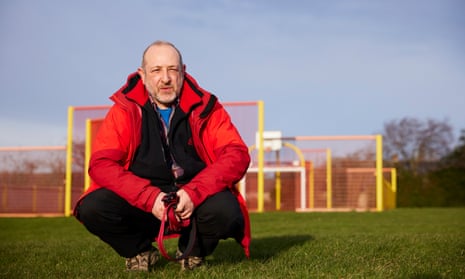Jean Rice worked as a nurse and then a carer for more than 30 years, until May last year, when she developed severe back and leg pain after helping to move a disabled woman in a wheelchair into a vehicle.
She has not been able to work since. “It’s really sad, because I love caring for people,” says the 64-year-old. “I love making a difference in somebody’s life by the littlest of things, just getting them comfortable. I can’t do it any more. I have to limit my activities, even walking, which I love.”
She is one of almost a million people now unable to do their jobs because of back or neck problems – up by more than a quarter since before the Covid pandemic.
Globally, low back pain is the single leading cause of disability, according to the World Health Organization, which is expecting cases to surge from 619m in 2020 to 843m in 2050, as populations age.
Eventually diagnosed with osteoporosis, and osteoarthritis in her hips and lower spine, which is exacerbated by physical activity, Rice is now trying to make ends meet on less than £100 a week in universal credit. She was initially on statutory sick pay, worth £109.40 a week, but it is payable only for 28 weeks.

“I’m having to ring my mortgage company, the utilities, because I can’t afford to pay anything,” she says. She is searching for another job that would put fewer demands on her body. “I don’t want to give up work,” she says, adding that the situation has affected her mental health.
Tony Wilson, the director of the Institute for Employment Studies (IES), says the sharp increase in painful musculoskeletal conditions is “partly a reflection of population ageing. We have a lot more people in their mid-40s to mid-50s now: it’s the children of the baby boomers”.
It is not just workers doing physical jobs such as Rice’s who are increasingly suffering back and neck problems. Shelly Asquith, the TUC’s spokesperson on health, safety and wellbeing, says: “Musculoskeletal injuries used to be a lot about manual handling in very physical jobs. More and more it’s being hunched over a desk, and that’s really skyrocketed with people working from home.”
Confined to their kitchen tables and spare rooms during the pandemic, many workers received little support from their employers to ensure their workspace was appropriate.
In one survey carried out among desk-based workers in mid-2020 for a project called Work After Lockdown, more than 40% of respondents said they were suffering more musculoskeletal pain than usual.
Asquith suggests the pressured nature of some screen-based jobs is also relevant. “There’s a big problem with work intensification, with people expected to do more with the time that they’ve got. We often focus on the stress impact of that, but there are also physical effects.” She underlines employers’ responsibilities to protect workers’ health and safety.
And while hybrid working opens up new flexibilities, it carries risks. One City worker who suffers from chronic back pain said the culture of hot-desking was unhelpful.
“We used to have our own computers at work and laptops at home. Now all of a sudden they remove all the fixed computers,” said the woman in her 30s, who did not want to be named.
“If you want to work from the office you have to carry your laptop, your mouse, your charger – everything. And your chair is not adjusted for you. That is going to create consequences.”
When her condition flares up, she has to work from home so that she can take periodic rests to lie on the floor.
The rise in back and neck conditions is a key factor behind a rapid increase in the number of people claiming sickness-related benefits: the Treasury paid out £1.4bn in disability benefits related to back pain last year alone. But the true economic impact is much larger, as many sufferers end up leaving the workforce.
Andrew Phillips, a senior researcher at Demos who has studied the issue, says more people with chronic conditions could be enabled to stay in work, with the right support.
Demos found that increasing the proportion of 55- to 64-year-olds in work in the UK from the current 65% to Germany’s 75% would boost GDP by £30bn.
Phillips pointed to the need for greater access to occupational health – which is widespread among larger employers but non-existent at many smaller firms – as well as supportive management.
Speaking to sufferers of chronic conditions about their experiences, he adds: “One of the things that was really striking was the difference between people’s experience with line management. A few people even said that they didn’t really discuss their condition, because they didn’t feel supported.”
That chimes with research from experts at Southampton University, published in the British Medical Journal, which showed that a key factor determining whether people with health conditions left paid work was job satisfaction.
Wilson of the IES says: “Employers need to be aware of how to support older people in work more generally. So much of this does come down to how to make work better and more supportive of good health.”
The chancellor, Jeremy Hunt, has acknowledged the challenge of health-related inactivity, and announced a series of measures, including a pilot scheme called Work Well, aimed at linking up employment and health support.
A government spokesperson said: “We are committed to providing the support people with back, neck and other major health conditions need to find a job that best suits them.
“Our back to work plan will help up to a further 1.1 million disabled people, people with long-term health conditions or the long-term unemployed to look for and stay in work.”

John Gessler, a 60-year-old from Barnsley who formerly worked as a programmer, has a long-term back condition that has prevented him from working full-time for many years.
“No one tells you how to be a patient; you’re on your own,” he says. “I ended up not being able to work at all. I ended up not even being able to get to the jobcentre to sign on.” With chronic conditions like his, he says, “you have to go through several stages of grief, because you’re waiting to be cured, and then your hopes get dashed”.
He benefited from an expert patient programme, then offered by the NHS, that helped him to understand and manage his condition, including through physical activity – and went on to become a tutor himself, which then led to other roles. “It was a lifeline for me: I wasn’t working at the time,” he says.
The expert patient programme is still running in some areas but the charity delivering it in many parts of the UK, Self Management UK, dissolved itself last year, saying it had been “swimming against the NHS tide”.
No longer working, Gessler keeps his condition under control with the help of physical activity. “I walk the puppy for two, three or four hours a day: that’s maintenance. I’m 60 years old and I can’t just bounce back any more.”
As someone who has worked with many patients with long-term health conditions, he argues employers need to think about how they can continue to benefit from experienced workers whose health limits what they can do.
“I would say, don’t consider illness in the workplace as an exception. It’s going to happen. It needs to be anticipated. What is your policy to support them, not to browbeat them? Are you ready to make someone a mentor, rather than a keyboard warrior?”








